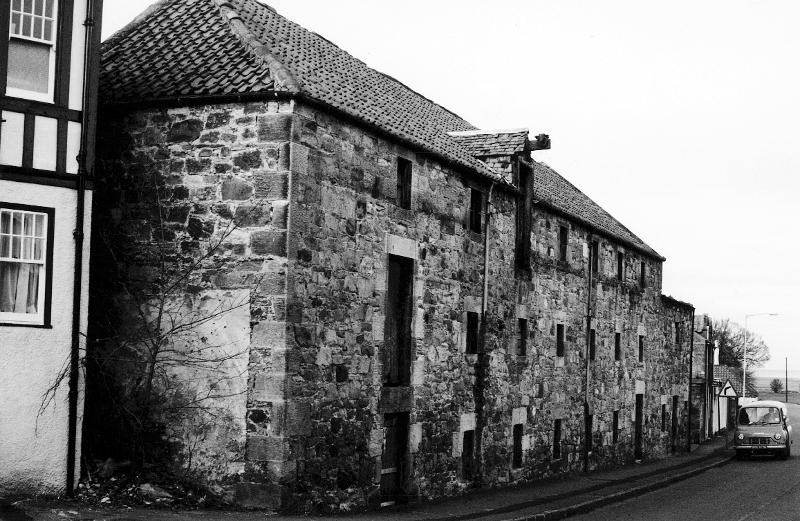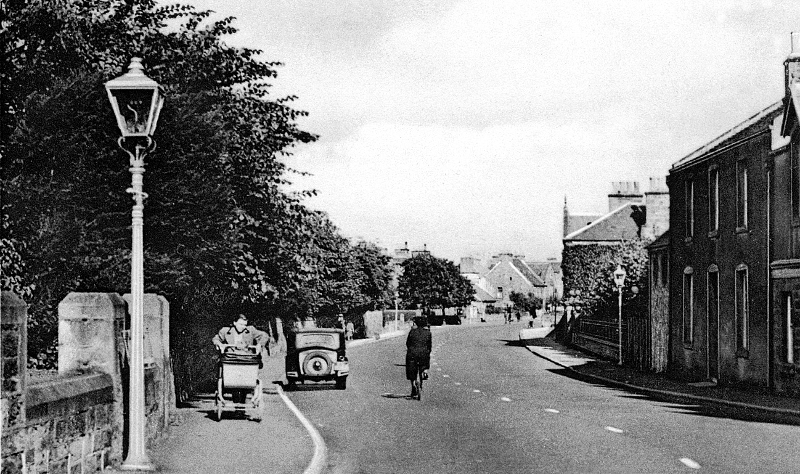Homes | Utilities | Shops & Services
For 20 years, from the late 1940s, council houses were built along School Road and, in the 1960s, in Rig Street, Rig Place, Kilspindie Court and Luffness Court – a total of 162. Many of these houses were roofed with modern pantiles to blend with the vernacular style of the village. Pantiles were also a feature of several of the subsequent private developments, notably the 13 houses built in 1977 at ‘The Gardens’, ground at the east end of the village that was previously a market garden, and the enclaves of Sinclair Court and Golf Court off the south and north sides of Main Street. The Maltings, the old malt warehouse in the Wynd, long derelict and an unsightly roosting-place for pigeons, was restored and converted into six flats and a house in the mid-1990s. Other developments included the 21 Miller houses at Luffness Gardens, ‘infill’ in Back Lane, and the 23 ‘executive-style’ houses at Craigielaw Park completed in 1999. All this additional housing arrested the decline in population, which rose to 1226 (ELCC parish estimate) in 1997. Wemyss Estates still maintained and rented out 35 houses within the parish.

The Maltings in The Wynd, Aberlady, before conversion.
The Draft East Lothian Local Plan (1994) designated a large area for new housing south of School Road, extending from Haddington Road westwards to Kirk Road. In Main Street, ‘The Poplars’, opened in 1933 as a holiday home for poor adults and children from Edinburgh’s Grassmarket, and later a home for the elderly, closed in 2000 and was sold for redevelopment as private housing. There were also plans for housing developments at the Wagon Inn and Aberlady Garage.
In 2002-2003, the ‘affordable’ houses built by Cruden included 3 and 2-storey teraced houses – 19 of them. The Cala development at the west end of the development (74 ‘executive-style’ detached houses) is called Garleton Park.

High Street, Aberlady, c1940s. The trees on the left are those of ‘Glebe House’, and the railings of ‘The Lodge’ can be seen on the right, in the middle distance.
Utilities
The public toilets, located at The Wynd, were demolished in 1991 after the Maltings had been sold for conversion into flats
The Aberlady & Gullane Gas Light Company‘s gasometer was situated adjacent to Aberlady station, supplying gas to Aberlady and to Gullane. It was closed down in 1958, having been nationalised in 1949 (Hajducki, A., 1992, pp79, 128).
The telephone exchange at Haddington Place was operated by a Miss Fortune, with helpers during the war years; it ceased in the 1950s, when the system became automated.
Dealing with rubbish: the vast increase in all kinds of packaging, the use of drinks cans and plastic bottles instead of the old-style returnable glass bottles, and the modern habit of both children and adults of casual eating and drinking out of doors or in cars, has produced a perennial problem of unsightly litter, particularly on the verges of the roads leading to and from the village. By 1980 Ally Punton, the last street sweeper – the old Scottish word ‘scaffie’ seems to be unknown to many younger people – had been replaced with his broom and barrow by a squad of men descending on the village periodically, but obstructed in their efforts by parked cars. The convenience of the modern ‘wheelie bins’ was perhaps discouraging some villagers from recycling their cans and bottles.
Shops & Services
Up to the 1960s, Aberlady was fairly self-sufficient, with a wide range of shops, including a bakery and grocery in what later became the Quill Gallery, where the ovens could still be seen, a butcher shop, now part of the Wagon Inn, a confectioner in the Wynd, and a haberdashery in a front room of ‘The Neuk’ at the eastern corner of the Wynd. In 2000, there remained only a privately run general store (run by East Lothian Co-operative Society until 1995), the ‘chip shop’, and the village post office.
Retail outlets included:
- Chip Shop – A Whiteford, Haddington Road; this business was carried on all during the war years and eventually closed in the 1950s.
- Miss Jane Scott – Draper, Milliner, Shoes & Haberdashery – The Neuk; Miss Scott carried on this business until she died in the 1950s. The business was taken over by Mr & Mrs James Gibson and continued as such until the 1980s.
- John Laing – the Wynd – Confectioner; this shop was bought over by Mr Robertson at the same time as he bought Waggott’s shop as the two shops were adjacent. Mrs Robertson carried on this shop as a confectioner until the 1980s when it became an antique shop for a short time. It is now a private house.
- Robert Guy – Main Street – Baker & Grocer; after having been in the ownership of Robert Guy since the l880s, it was sold after the war and was carried on as a grocer’s shop with various owners until 1975 when it became a craft shop – the Quill Gallery.
- Fairbairns – Main Street – Confectioner, Hardware, Drapery & Newspapers; on the retirement of the Fairbairns, this shop was taken over by Robert Guy in the 1940s. It continued as a private business until the East Lothian Co-operative Society Ltd bought it. It traded as the Co-op until 1995. It has now become a privately owned business once again and is still a village store.
- Eeles/Cameron – Main Street – Butcher; the business of butchers was carried on in the property adjoining the Wagon Inn (which is now a private dwelling-house). Eeles was the butcher for many years until after the war when Cameron (butcher, Gullane), took over the business until the early 1970s.
- The village had many services on offer as well, with a chimney-sweep, a coal merchant, a boot repairer, an undertaker, and a golf club maker, Willie Waggott, who specialised in wooden-shafted clubs at his shop in the Wynd – W. Waggott of the Wynd. Aberlady even had its own registrar, Alec Yorkston, until the parish records were centralised.
Services included:
- Gabriel Sinclair – Loan Villa; farmer, coal merchant and dairy. Supplied village with coal and dairy produce until 1970s. Cultivated the rigs at the back of the village before this land was acquired for housing.
- Smiddy – blacksmith; this ceased as blacksmith and was used as paint shop 1950/51 by James Ford and later by W Wilson, painter, until the 1970s.
- Jim Gow – Joiner & Cabinetmaker; this business ceased in 1962.
- Cuthbert – Joiner & Undertaker; ceased in 1955 on the death of Mr Cuthbert but business as joiner carried on by James Cunningham, Mr Cuthbert’s nephew, until his death in 1980.
- W. Waggott – The Wynd – Golf Clubmaker; Mr Waggott was well known for his golf club making and his speciality was making wooden-shafted clubs and gutta percha golf balls. This business was carried on for many years prior to the war and only ceased on Mr Waggott’s death in the early 1950s. The shop was then sold to Mr Robertson who was an electrician and he carried on business there until he died in the 1970s.
- Sandy Lambert – Merrilees Cottage – Slater, Plasterer and Chimney sweep; this business was carried on until Mr Lambert’s death in the 1950s.
- Frank Burns – Back Road – Boot Repairer; this business of boot repairer was carried on before the war and ceased in 1950s.
- Brian Ford – Luffness Court – Joiner; business commenced in 1980s, and is still in existence.
Registrar – Births, Deaths & Marriages: Alec Yorkston was the registrar of the parish records until 1968 when they became centralised and, for this part of the county, were located in North Berwick.
Over the period there were several hotels in the village; by 2000, only two – the Kilspindie House Hotel, and the Old Aberlady Inn – offered accommodation, together with Green Craigs, which lay outwith the village.
Temperance Hotel – Main Street – Steanes; this was also a coal merchant, confectioner, newspapers etc. Ultimately it became a newsagent and confectioner with some groceries, combined with a ‘chip shop’, which was installed in the premises and is now licensed to sell drinks. It continues as such today but is no longer a newsagent.
The Golf Hotel – now known as the Old Aberlady Inn. After various owners, this hotel continues as such along with a restaurant, cocktail bar and public bar.
The Wagon Inn, Main Street; this public house business was in the ownership of George W Guy from 1900 until 1935 when it was sold on. It continued as such until 1978 when Graham Young bought it and changed it into a restaurant and bar. This continued until 1994. The buildings and ground have now been sold for housing.
The Kilspindie House Hotel, Main Street, was converted from a private dwelling house into a bed and breakfast boarding house in the 1950s. After that it was taken over in 1967,by the Binnie family who ran it as an hotel. Later they extended the building to take in the ground where the old Aberlady public school had been situated. The Binnie family sold the hotel in July 2000 and the new owners continue to run the hotel.
A mobile library service was introduced in Aberlady in 1968, before which the village library – with books donated by the Traill Bequest – was kept in the primary school. By 2000, the van visited the village every Friday, with additional services for schoolchildren and the Mothers & Toddlers Group.

Robertson’s sweet-shop, The Wynd, Aberlady, was once occupied by a golf club maker, then a cycle shop, then was a sweet shop from 1950s – 1970s. Bay Cottage now stands on the site.